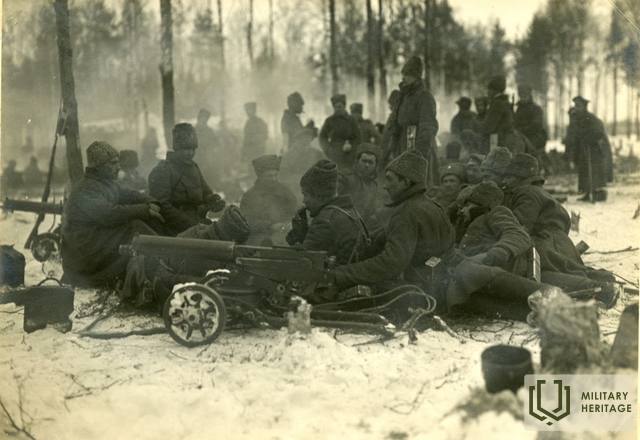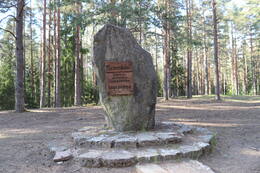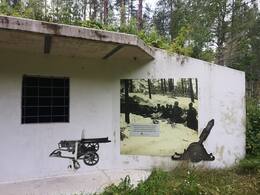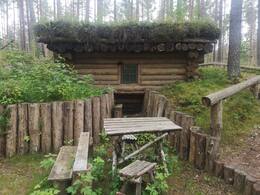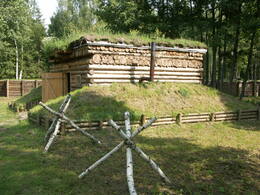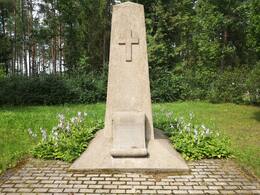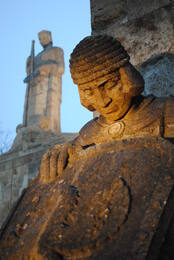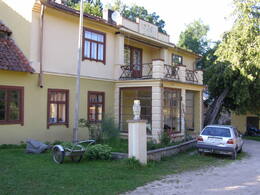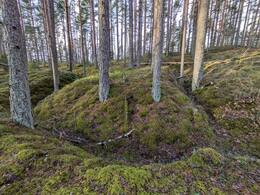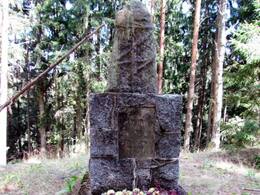Kalėdų mūšiai I WW1
Kalėdų mūšiai visiems laikams įrašyti į Latvijos istoriją kaip tragiška ir kartu herojiška istorija. 1917 metų sausio 5 dieną Rygos fronte prasidėjo Rusijos 12-osios armijos puolimas, kurio oficialus pavadinimas buvo „Jelgavos operacija“. Pagal senąjį stilių, arba Julijaus, kalendorių, puolimas prasidėjo gruodžio 23 d., tai yra Kūčių vakarą. Todėl šie mūšiai, kuriuose pirmą kartą kartu dalyvavo visi latvių šaulių pulkai, buvo pavadinti „Kalėdų mūšiais“. Kalėdų mūšiai ir vėlesni sausio mūšiai buvo tragiškiausi ir kartu vienas herojiškiausių latvių šaulių istorijos puslapių.
Rusijos kariuomenė suplanavo didelį Vokietijos imperatoriškosios armijos puolimą, pagrindiniu smūgiu panaudodama latvių šaulius. 12-osios armijos vadovybė ketino staigiais smūgiais be išankstinio artilerijos pasirengimo pralaužti vokiečių frontą keliose vietose plačioje teritorijoje nuo kairiojo Lielupės kranto iki Jelgavos plento. Išpuolis įvyko pelkėtoje vietovėje tarp Babytės ežero ir Olainio, kuri vadinosi Tīreļpurva. Rusija buvo užsibrėžusi tikslą išlaisvinti Jelgavą, o jei pasiseks – visą Žiemgalą ir Kuršą.
Puolimo fronte Rusijos kariuomenė subūrė savo pajėgas, užsitikrindama pranašumą: iš viso beveik 100 000 Rusijos armijos karių prieš 20 000 vokiečių armijos karių. Puolimas turėjo vykti 8 vietose, iš kurių 2 turėjo būti įvykdyti latvių šaulių pulkai, suskirstyti į dvi brigadas. Abi latvių brigados puolimui ruošėsi ilgai. Šauliai buvo kruopščiai mokomi įveikti spygliuotos vielos tvoras ir paimti priešo įtvirtinimus. Šaulių nuotaika buvo labai gera, visi tikėjosi ankstyvo Žiemgalos ir Kuršo išlaisvinimo.
Deja, puolimo aprūpinimas ir vadovavimas buvo prastai suplanuoti ir įvykdyti, todėl darbo jėgos pranašumas nepadėjo. Mūšis vyko atakomis ir kontratakomis. 2-oji latvių šaulių brigada sėkmingai pralaužė pirmąją vokiečių įtvirtinimų liniją, užėmusi pietinę Tīreļpurvo dalį. Dvi paras -36°C saloje šauliai laikė užgrobtą teritoriją, tačiau sausio 7 dieną puolimą pasuko į šiaurę, vokiečių įtvirtinto Ložmetējkalno link, kurį tą pačią dieną užėmė. Kitą dieną, sausio 8 d., latvių šauliai atmušė keletą įnirtingų vokiečių kontratakų, kurių tikslas buvo atgauti anksčiau prarastas pozicijas. Ložmetējkalno užgrobimas vokiečiams tapo didžiausia Kalėdų kovų sėkme. Deja, Rusijos vadovybė Ložmetējkalno užėmimo nepanaudojo Kalnciemo puolimui, kuris galėjo būti įvykdytas tą pačią dieną, vokiečiams nespėjus konsoliduotis ir atvesti atsargų.
Kalėdų mūšiai tapo žinomiausiomis ir legendinėmis latvių šaulių kovomis. Latvių šauliams pavyko tai, ko nepavyko padaryti jokiam Rusijos daliniui Rygos fronte – pralaužti vokiečių įtvirtinimus ir užimti apie 30 kvadratinių kilometrų plotą. Tai buvo pirmas kartas, kai visi latvių šauliai kovėsi kartu petys į petį.
Kalėdų kautynių metu tiek rusų daliniai, tiek latviai patyrė labai didelių nuostolių. 12-osios armijos nuostoliai siekė 19 000 karių. Latvių pulkai sausio 5–11 dienomis neteko 5364 šaulių, iš kurių 874 žuvo, o maždaug 400 dingo be žinios. Laimėjimai iš mūšių nebuvo dideli. Dideli nuostoliai smarkiai pakirto latvių ištikimybę Rusijos imperijos valdžiai ir tapo lūžiu tiek šaulių, tiek Latvijos istorijoje.
Daugiau informacijos šaltinių
1. Sielų pūga. Skaitmeninis muziejus. Prieiga: https://www.dveseluputenis.lv/lv/laika-skala/notikums/85/ziemassvetku-kauju-sakums/ [žiūrėta: 2021-05-05].
2. Latvijos radijo 2 Latvijos šimtmečio istorijos straipsniai „Kalėdų mūšiai“, 2017 m. Prieiga: https://lr2.lsm.lv/lv/raksts/latvijas-simtgades-stastu-raksti/ziemassvetku-kaujas.a97478/?highlight=str%C4%93lnieki.05.2
3. lsm.lv laidos „Vēstures ķilis“ serialas „Pokalbis su istoriku Jāniu Šiliņu apie kalėdines kovas ir šaulius“, 2017. Prieina: https://naba.lsm.lv/lv/raksts/vestures-kilis/saruna-ar-vesturnieku-jani-silinu-par-kaujammas/4%str. 93lnieki [žiūrėta: 2021 05 05.].
Susijusi laiko juosta
Susijusios vietos
Kulkosvaidžio kalnas Tyrelio pelkėje
Kulkosvaidžio kalnas (Ložmetėjkalnas) yra Jelgavos apy linkėse, Valgundės seniūnijoje, šalia automagistralės A9. Tai Pirmojo pasaulinio karo mūšių vieta ir vienintelis vals tybinės reikšmės kultūrinis ir istorinis draustinis Latvijoje. Ložmetėjkalnas yra ant Ilgosios kopos, priklausančios Nor dekių–Kalnciemo kopagūbriui. Pavadinimas atsirado tais laikais, kai čia buvo įrengti neįveikiami Vokietijos kariuo menės įtvirtinimai, ginami sunkiaisiais kulkosvaidžiais. Kalėdų mūšiai – vienas žinomiausių ir dramatiškiausių Pirmojo pasaulinio karo įvykių Latvijos istorijoje. 1917 m. Ložmetėjkalną puolė ir užėmė Rusijos kariuomenės latvių šaulių bei sibiriečių daliniai. Jie paėmė į nelaisvę apie 600 priešo karių ir užgrobė vertingų trofėjų. Patys šauliai tvirtino, kad būtent jie nusipelnė vadintis šios aukštumos užkariautojais. Kulkosvaidžio kalno (Ložmetėjkalno) apylinkėse yra išlikę atminimo ženklai ir kitų čia vykusių mūšių liudijimai. Kas met sausio mėnesį čia vyksta renginiai, skirti Kalėdų mūšių atminimui. Ši vieta tapo latvių šaulių didvyriškumo ir narsos simboliu. Čia pastatytas 27 m aukščio apžvalgos bokštas, nuo kurio atsiveria Kalėdų mūšių vietos vaizdas.
Latvian soldiers’ former medical warehouse
Located in Babīte district, near the Antiņi soldiers cemetery and restored trenches.
During World War I, from 1915, defensive positions of the army of the Russian Empire were located in this area. In 1917, during the Christmas battles, at the Antiņi house was the headquarters of the 5th Zemgale Latvian Rifle Regiment and an infirmary with a medicine warehouse, which was headed by the prominent Latvian military doctor Pēteris Snīķeris.
During the Christmas battles, the attacks of Latvian riflemen on German army units took place in particularly harsh and unfavorable conditions. The injuries sustained in the fighting were of all kinds - wounds, contusions and injuries caused by firearms, as well as frostbite. Thousands of Latvian soldiers had to be provided with timely medical assistance. It was organized so that the injured received care as soon as possible. There were unarmed paramedics on the battlefield who provided first aid and removed the wounded from dangerous places. Dressing points were set up in the vicinity of the battlefields, where care was continued and sorting was carried out. Severely wounded soldiers were evacuated to hospitals or hospitals in carts and cars. Cemeteries were set up near Lazarete, where the dead were buried.
Nowadays you can see the old medicine store. The Antiņi Soldiers Cemetery is nearby, as are World War I trenches and dugouts. The environment is suitable for walks in the woods, revealing vivid evidence of military heritage.
Latvian riflemen positions and trenches in Tīreļi
Latvian Riflemen dugouts and trenches in Tīreļi are located in Babīte parish, Mārupe municipality, in the vicinity of the Antiņi Latvian Riflemen Cemetery and the former medicine warehouse. During World War I this was the defensive position of Latvian Riflemen of the Russian Imperial Army. A complex of trenches and surface dugouts was built in the sandy hills. Trench or positional warfare is the best way to accurately describe World War I and emphasise the importance of fortifications. They were based on the research of military engineers and adapted to the environment and the development of new weapons. The everyday life of a soldier is a continuous improvement of defensive fortifications. Sometimes soldiers would give the dugouts names that reminded them of their homes and would help to forget about the reality of the war. Trench lines were complex defensive systems that were hard for the enemy to take. With the development of weapons these defences became even more sophisticated. The roofs of dugouts were reinforced to withstand artillery shells. Trenches were made in changing patterns and directions so that explosions would cause as little damage as possible. Movement passages had pockets that were used as short-term hiding spots during artillery fire, because they protected soldiers from shrapnel and rubble. Today part of the fortification has been restored and you can visit 3 restored dugouts and a 100 m long section of the trenches.
Kalėdų mūšių muziejus
Muziejus, įsikūręs sodyboje „Mangaļi“ Jelgavos apylinkėse, Valgundės seniūnijoje, yra Latvijos karo muziejaus filialas. Jis atidarytas 2005 m. toje vietoje, kurioje per Pirmąjį pa saulinį karą vyko Kalėdų mūšiai. Šiose vietose iki šiol tebėra išlikę išskirtiniai Pirmojo pasaulinio karo įtvirtinimai. Kalėdų mūšių muziejaus ekspozicija yra įrengta autentiškoje vieto je po atviru dangumi. Čia galima pamatyti rekonstruotą įtvirtinimų sistemos fragmentą – lauko slėptuvę ir dalį pir mosios vokiečių gynybos linijos, vadinamos „vokiečių pyli mu“. Tai vienintelis tokio pobūdžio objektas Baltijos šalyse. Kalėdų mūšiai – vienas žinomiausių ir dramatiškiausių Pir mojo pasaulinio karo įvykių Latvijoje. Jie užima ypatingą vietą latvių karo ir kultūros istorijoje. Intensyvūs mūšiai truko šešias dienos ir pareikalavo daug aukų. Šie įvykiai dažniau siai siejami su latvių šaulių puolimu prieš Vokietijos kariuo menę, vykusiu ypač atšiauriomis ir nepalankiomis žiemos sąlygomis. Tai buvo pirmas kartas, kai didelio masto puo limas vyko be artilerijos palaikymo. Šiuo metu muziejuje eksponuojami mūšių vietose rasti radi niai. Vidaus ekspozicija lankoma nustatytu laiku, o po atvi ru dangumi esančių įtvirtinimų ekspoziciją galima apžiūrėti kiekvieną dieną. Apylinkėse sudaryti turistiniai maršrutai ir įrengti pažintiniai takai.
Christmas battles memorial at Antinu Brethren Cemetery
Located in Babīte district, on the side of the road near the former Antiņi house and the old medicine warehouse.
The cemetery of Antiņi or Tīreļi soldiers was established during the First World War. The defense positions of the army of the Russian Empire were located in the area. In 1917, during the Christmas battles, the headquarters of the 5th Zemgale Latvian Rifle Regiment and an infirmary with a medicine warehouse were located nearby.
In the night of January 5, 1917, in the light of eight huge bonfires, 105 fighters of the 5th Zemgale Latvian Rifle Regiment were buried in military honor. They fell in battle against the German army or died from injuries. The funeral ceremony was led by Regiment Commander Jukums Vācietis. In later years, soldiers from other units of the Russian army were also buried in the cemetery. In 1925, a monument to the architect Eizen Laube was unveiled in the cemetery, and the territory was landscaped. Information about the 3,800 soldiers buried in the cemetery can be found in many places, but it must be assessed as unlikely and unverified.
Brothers' Cemetery in Riga
Riga Brothers’ Cemetery is located in the northern district of Riga. The cemetery extends over an area of 9 ha and is the most outstanding and significant memorial ensemble in Latvia dedicated to the fallen Latvian soldiers. About 3,000 soldiers are buried here. The Brothers’ Cemetery was created during World War I after the first three Latvian Riflemen, who fell in Tīreļpurvs in the battle against the German Army, were buried here. Later Latvian soldiers who had died in other battles and wars would also be buried in the Brothers’ Cemetery. The memorial is based on the design of the sculptor Kārlis Zāle, and is the first memorial ensemble in Europe with such landscape, architecture and sculptural value. It uses elements typical to the Latvian landscape, traditional farmsteads, Latvian folklore and history that praise the characteristics of soldiers and tell the story of the way of the soldier. The memorial was unveiled in 1936 and it has three parts: ‘The Road of Though’ which is a 250 m long alley, ‘Terrace of Heroes’ with the Altar of the Sacred Flame and ensemble the Sacred Oak Grove, and the burial ground with the Latvian wall and a memorial of a mother with her fallen sons.
General L. Bolstein Museum
It is located 17 km from Kandava in Pucesdzirnavai, Matkule parish.
The memorial room of Latvian Army General Ludvig Bolštein was created in the territory of the Pūce mill, in a rest house. The property was once rented by the Bolstein family. Since the 19th century at the end of the century, a sawmill, a grain mill, and sheep's wool were processed here.
Ludvig Bolšteins was one of the most experienced Latvian soldiers who actively participated in the creation of Latvian rifle units. Participated in the War of Independence and the creation of the Latvian state. At the beginning of World War 2, Ludwig Bolstein was an example who demonstrated complete non-cooperation with the Soviet occupation regime. One of the two senior officers of the Latvian Army, who committed suicide because he did not want to cooperate with the Soviet occupying power. The general's letters before his death are a vivid source of history, which allow a better understanding of the personality and the situation in which the country of Latvia was at the beginning of World War II. The letters read: “To your boss. We, Latvians, built a new, stately building - our country. A foreign power wants to force us to tear it down ourselves. I can't participate." On the other hand, the text of another letter was addressed to the mother: "Mother, I'm sorry, I couldn't do it otherwise."
By applying in advance, you can visit the memorial room and familiarize yourself with the exposition dedicated to the general.
Nordeķi – Kalnciemas dune ridge
The approximately 30 km long dune ridge, which can be traced in nature from Iļģuciems (with minor interruptions) to Tīreļi today, is one of the most impressive landforms of the Seaside Lowlands, which is rarely perceived as a single natural formation. The dune was formed on the shores of one of the last Baltic glacial lakes, as the waters of the Baltic glacial lake receded. The dune ridge consists of two parallel 50–100 m wide dune belts. They are usually 6–10 m high, but their highest points reach 16–19 m above sea level. In the vicinity of Kleisti, Imanta and Beberbeķi, the beautiful pine forests covering the dunes are a popular place for walking, recreation and sports, and in winter - cross-country skiing. The part of the dune in the vicinity of Lāčupīte is associated with the events of the Bermontiades. On the dune in Pārdaugava is the Lāčupe or Lācaras cemetery . Between Pinkie and Babīte, the Beberbeķi Nature Park has been established to preserve the dunes. The western part of the Nordeķi-Kalnciemas dune ridge, approximately 10 km long, is called the Long Dune . Near the Long Dune (south of Trenči) is the Antiņi Brothers Cemetery , the Latvian Riflemen's Hospital medicine warehouse , and the renovated Latvian Riflemen's dugouts . South of the Long Dune is a massif of swampy forests and marshes, including Rāvājs and Maztīrelis . Opposite Maztīrelis is Ložmetējkalns with a viewing tower and a resting place and the so-called German rampart section . Even further west, near the Long Dune are the Latvian Riflemen Brothers Cemetery and the Piķi Brothers Cemetery. With greater or lesser interruptions, trenches are visible almost along the entire Nordeķi-Kalnciemas dune ridge. In the southwestern part of the Long Dune – in the swampy forests that adjoin it from the south, bomb craters from the First World War are visible. Along the entire length of the Long Dune (south of it), small forest paths run, suitable for walks and longer hikes – a great opportunity to explore the sites of the First World War battles.
Krači Mountains Monument
The Krāči Hills are one of the largest coastal dunes of the Litorina Sea. Its highest point is 29 m above sea level and 26 m above the surrounding plains. The Litorina Sea is said to be the predecessor of the Baltic Sea, which existed approximately 7,000 to 5,000 years ago.
The 6th Special Brigade of the 12th Russian Army launched the attack from the Krāči Hills during the Christmas Battles, with the task of breaking through the German front from the Great Tīreļi Swamp to the Lielupe River. During the month-long battles, the Russian army gained an area of 25 square kilometers, but the losses were enormous – 45 thousand fallen, wounded and missing soldiers. The losses of the Latvian riflemen were 9 thousand fallen, wounded and missing soldiers. During the Christmas Battles, the Latvian riflemen gained immense fame as heroic and brilliant soldiers, paying a very high price for it – their lives.
A monument has been erected in memory of those who fell in battle. Every year on November 11, Lāčplēsis Day, and on November 18, the anniversary of the proclamation of the Latvian state, candles are lit at this place in memory of the fallen heroes.
The protected nature area "Krāči Mountains" as a dune mound of the Litorina period
Susijusi istorija
Įrašas dienoraštyje apie momentą, kai kariai sužino apie pasiruošimą kalėdinėms kautynėms.
Latvių lankininkai ir jų karininkai apie mūšio pradžią buvo informuoti paskutinę akimirką. 5-ojo Žiemgalos latvių šaulių pulko puskarininkis Rudolfas Ivanovas savo dienoraštyje aprašė paskutinį vakarą prieš mūšio pradžią. Trumpas, bet ryškus ir autentiškas tekstas, parodantis labai svarbų kariui momentą – jis sužino apie mūšio dieną.
Gynybinių pozicijų formavimas.
Aprašyme apskritai nagrinėjama mūšio lauko įtvirtinimo problema. Jis sukurtas remiantis I pasaulinio karo patirtimi ir situacija, kai būtina organizuoti didelius įtvirtinimų kūrimo darbus.
Kieme rastas Admirolui Makarovui skirtas atminimo ženklas
Maža karinė relikvija gali papasakoti didelę istorinę istoriją. Ir nors ženklelis reprezentuoja Rusijos ir Japonijos karo metu vykusius įvykius, jis parodo languotą karo istoriją ir mūsų latvių šaulių įsitraukimą į kitus karinius konfliktus tiek prieš Nepriklausomybės karus, tiek po jų.




